People keep asking us, "How long are you going to keep doing this?" I'm not sure if they are surprised at out resilience, persistence or appetites, but here we are...another week, another new Latin eatery. This past week as we sat down to sup at Manana, in the Dayton's bluff neighborhood of St. Paul, we were anything but discouraged. Owner, Balmore Paiz certainly made sure that we were both well fed and well informed.
Manana is anything but ordinary, as anyone paying attention will notice. From the friendly and kind owners to the diverse menu and excellent food, we can assure you that it is worth the trip. The first thing to know is that Rosario Diaz, Balmore's mother is the heart and soul behind Manana. Hailing from El Salvador, she has been serving up tasty food for more than twenty years. First in southern California and then for the past 13 years, here in the twin cities, Balmore told us that the whole thing started in their home.
The specialty of the house is a wonderful creation called the pupusa, hence the name you will sometimes find for the establishment: Manana restaurante and pupuseria. These treats are hand formed corn cakes that are filled with different options, such as cheese, beans, and various meats. Before they opened the current establishment, these treats were discovered by friends and neighbors to the point that, according to Balmore, "There were suddenly too many people in our house, eating, watching my tv." So for the past five years, they have been serving the community on the corner of 7th and Arcade, just NE of downtown St. Paul.
They have kept their handmade quality and created a menu that is half El Salvadorian and half Mexican, all of it seemingly well done and fresh. As a matter of fact, Rosario is so particular about their ingredients that she is often out at local chicken farms inspecting and selecting birds for their restaurant. Because of this, it is not uncommon that certain items may not be available if the "chickens are not ready" or certain other ingredients are not up to par.
Balmore also told us that being so close to the downtown farmers market, they often have farmers stop by for lunch and to drop off fresh corn and other veggies. We really appreciate their dedication to healthy food and local farms and hope to hear more of it. This harkens back to our original decision to take on this Latin eating challenge as laid out in our intro article. From the beginning, we have appreciated the balance of meat, veggie, grain and legume in most Latin cooking. It may often seem like Latin eateries focus on meat and many do, but Manana made vegetables a prominent part of the meal. We consumed cabbage, peppers, carrots, potatoes, onions, tomatoes, cilantro, melon and plantain along with our beans, rice, corn, pork, chicken and beef.
Ordering was not easy and it wasn't because of a language barrier. The more we do this, the more we want to try and no matter how much we work on it, our stomachs can only hold so much. We knew we were going to get tacos and tamales to start and that we had to try a pupusa. But then, things got much more difficult. Faced with Mexican food alone, we have a hard time, but when you add a whole other food culture to the mix, it is almost impossible. These are the times when we are glad that we decided to have the workers help us decide on our final two dishes...or three or four.
Balmore made sure that we were ordering pupusas and then suggested a few favorites. Still at a loss, we ordered the highly touted chilaquiles with asada and then decided on an appetizer called pasteles con carne (literally meat pastries). We got up to survey the counter/deli area and noticed that we made a potential lapse in judgement. Were we too hasty? Next to the register, on their hot line 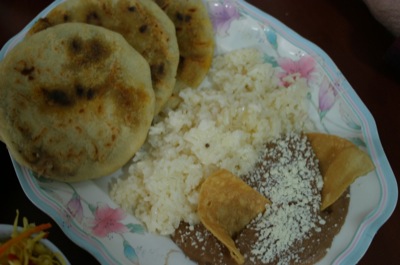 Pupusa platterwere all sorts of dishes not necessarily on the menu: liver and onions with an El Salvadorian tomato onion sauce, there were ribs with vegetables and other curious stews, soups and mouth watering options. Lesson 1: too much good food can be a burden.
Pupusa platterwere all sorts of dishes not necessarily on the menu: liver and onions with an El Salvadorian tomato onion sauce, there were ribs with vegetables and other curious stews, soups and mouth watering options. Lesson 1: too much good food can be a burden.
We watched the pupusas being made as we talked further with Balmore. First they hand pack one cake, top it with fillings, then add another hand-formed cake on top. It then goes on the griddle to cook until nicely browned. As always, with handmade food, the wait is worth it.
The food came out looking extremely good and hot. I personally always do three things when food like 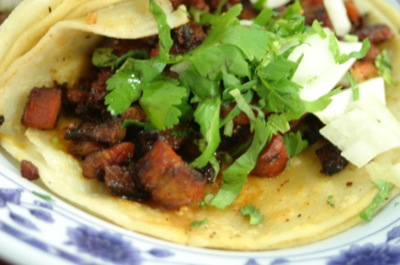 al pastorthis comes out. Take pictures for the website (which is extremely difficult when you are hungry), steal a bite of the taco meat and help myself to a fried appetizer while they are still mouth scorchingly hot. Right away, I knew that we were dealing with some discerning cooks. The al pastor was absolutely delicious. This was not your typical bright red, hint of pineapple, from a vertical rotisserie pastor. This was a homemade, well charred and perfectly marinated and seasoned take on pastor. It was hard to just have one taco al pastor. The other taco we ordered with carnitas. Their take on carnitas was the "pulled pork" variety and was also very tasty, especially with some of their homemade arbol salsa on top. Be warned...it is extremely hot and if you take some home, warn your family (just ask my wife).
al pastorthis comes out. Take pictures for the website (which is extremely difficult when you are hungry), steal a bite of the taco meat and help myself to a fried appetizer while they are still mouth scorchingly hot. Right away, I knew that we were dealing with some discerning cooks. The al pastor was absolutely delicious. This was not your typical bright red, hint of pineapple, from a vertical rotisserie pastor. This was a homemade, well charred and perfectly marinated and seasoned take on pastor. It was hard to just have one taco al pastor. The other taco we ordered with carnitas. Their take on carnitas was the "pulled pork" variety and was also very tasty, especially with some of their homemade arbol salsa on top. Be warned...it is extremely hot and if you take some home, warn your family (just ask my wife).
 The tamale was a bit unique compared to most of the others that we have ordered. We really wanted to try the tamal de elota con crema y frijoles, a sweet corn tamale served with cream and beans...but alas, they were out of the special sweet corn that they use to make them. Next time. What we ordered was the basic tamal de pollo. It was a very welcome change from your everyday tamal. For one, the masa was soft, mild, fine and white. Secondly, as explained by Balmore, the sauce was homemade, a blend of tomatoes, carrots, green beans and other vegetables. There was just the right amount of chicken and overall, it was a nice, if not mild, tamal more similar to those we've had from Central and South American locales.
The tamale was a bit unique compared to most of the others that we have ordered. We really wanted to try the tamal de elota con crema y frijoles, a sweet corn tamale served with cream and beans...but alas, they were out of the special sweet corn that they use to make them. Next time. What we ordered was the basic tamal de pollo. It was a very welcome change from your everyday tamal. For one, the masa was soft, mild, fine and white. Secondly, as explained by Balmore, the sauce was homemade, a blend of tomatoes, carrots, green beans and other vegetables. There was just the right amount of chicken and overall, it was a nice, if not mild, tamal more similar to those we've had from Central and South American locales.
Moving on to the pasteles con carne, I must admit that I was excited to have a little fried food. I don't eat fried food very often at all, so when I do, it is quite the treat. These did not let me down. Not only 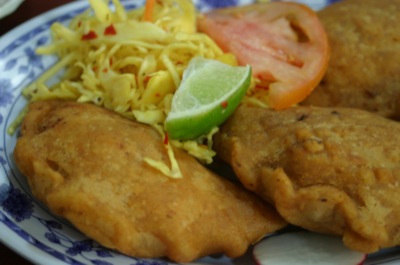 Pasteles con carne and curtidowas the filling balanced and well-made, these morsels were served with curtido, a spicy cabbage slaw. As for the filling, it was a homemade mix of ground beef, carrots, peppers, potatoes, onions and more. For how nice and greasy the shell was, the filling was not oozing with grease, which was great. Too often, I avoid ground beef because I do not like heavy, greasy ground meat. This was not that. These also passed our "cold test," meaning that they were still good after they cooled off. A sure sign of good ingredients and fresh, not rancid oil. These are highly recommended.
Pasteles con carne and curtidowas the filling balanced and well-made, these morsels were served with curtido, a spicy cabbage slaw. As for the filling, it was a homemade mix of ground beef, carrots, peppers, potatoes, onions and more. For how nice and greasy the shell was, the filling was not oozing with grease, which was great. Too often, I avoid ground beef because I do not like heavy, greasy ground meat. This was not that. These also passed our "cold test," meaning that they were still good after they cooled off. A sure sign of good ingredients and fresh, not rancid oil. These are highly recommended.
Charles was working on the pupusas. The type we ordered were filled with refried beans, mozzarella and carnitas. They looked very good and upon first bite, you get that satisfying experience of something well cooked, yet still a tiny bit chewy. I can see why they are so popular. There is something so satisfying (and very filling) about a nice thick masa cake with plenty of cheese, beans and meat. These are also served with curtido, refried beans and rice, a very complete and filling meal. I think the ones served with chicharron (pork skin, rinds, etc.) would also be very tasty. Please let us know your favorites if you have tried the other varieties!
On to the chilaquiles. Since we have become absolutely fascinated with this dish in all its forms, I think that it deserves a bit of a mention. If you are new to this dish, let me explain what I know and hopefully some other folks will comment on what they have learned about chilaquiles. From what I can tell, chilaquiles were originally made with tortillas cut into quarters and fried. As things always evolve from both creativity and resourcefulness, this dish can come in many different forms. They range from something like nachos, where the sauce and toppings are added to the tortillas or chips right before they are served, to something more like polenta, due to long simmering.
Most often, what we find is actually more like a tex-mex dish called migas. Migas is generally a "breakfast" dish made with crushed tortillas chips simmered with sauce and topped with eggs. You find this dish regularly in Texas, 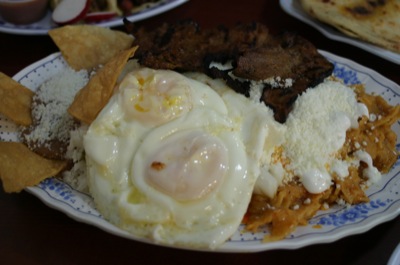 Chilaquiles...or are they migas?California and Colorado, among other southwestern states. The version of chilaquiles that we had was more like migas in my opinion. It was a nice pile of chips simmered with a quite spicy roja sauce and was then topped with fried eggs, cheese and sour cream. As recommended by Balmore, we added a thin, charred piece of carne asada, which gave a nice smoky, meaty element to this already rich, spicy and complex dish. It also made it a rather huge meal. In the end, I loved this dish, and almost always do, in every form. If the sauce is good, it seems hard to go wrong with chilaquiles. The only thing that I might change would be the meat. For how much I love the flavor of a nice grilled piece of flank steak, it is usually a bit too chewy for me. Next time I go, I think I will have it with the al pastor on top. It will still add the nice char flavor and more.
Chilaquiles...or are they migas?California and Colorado, among other southwestern states. The version of chilaquiles that we had was more like migas in my opinion. It was a nice pile of chips simmered with a quite spicy roja sauce and was then topped with fried eggs, cheese and sour cream. As recommended by Balmore, we added a thin, charred piece of carne asada, which gave a nice smoky, meaty element to this already rich, spicy and complex dish. It also made it a rather huge meal. In the end, I loved this dish, and almost always do, in every form. If the sauce is good, it seems hard to go wrong with chilaquiles. The only thing that I might change would be the meat. For how much I love the flavor of a nice grilled piece of flank steak, it is usually a bit too chewy for me. Next time I go, I think I will have it with the al pastor on top. It will still add the nice char flavor and more.
We thought we were done at this point. We felt very done. Balmore, though, had other ideas. He absolutely insisted that we try the empanadas. These were to be our true treat, more than the fried pasteles and the cantaloupe juice that Charles was drinking, these little dessert nuggets were deep fried balls rolled in sugar and filled with plantain and a yogurt/milk sauce. What I loved about these hot delicacies was that they were not too sweet. I think too often the subtleties of the plantain can be lost with too much sugar. They were creamy, fresh tasting and would be great with a cup of black coffee.
In the end, I can honestly say that I could recommend any of the above items. I think that the pupusas, al pastor and pasteles con carne were my absolute favorite items. Next time I go, I definitely want to try some of the daily specials on the hot deli line, a sope instead of a taco and some yuca frita. I also really hope that they have those sweet corn tamales and a drink called atol de elota (sweet corn milk, served hot). Balmore really raved about this last one, but we simply did not have room.
Here are the details:
Manana restaurante and pupuseria
828 E 7th St
St. Paul, MN
651-793-8482
Hours: Mon-Thur 8 to 8 and Fri-Sun 8-9
Prices:
Tamal $1.5
Tamal de elota $4.5
Tacos $2
Burritos $7.5
Enchiladas $8.5
Chilaquiles $7.5
Pupusa combo (3 pupusas w/curtido, rice, beans) $8.5
Single pupusa $2-$3
Tortas $7.5
Sopes $5
Callina India and other soups $8-$10
Pasteles con carne $3.5
Yuca frita $6.5
Empanadas 3 for $4
Surprise: our first real farm to fork experience in the Latin tongue series, also the truly handmade nature of the food.
Payment: cash or credit
Language: Balmore was our server and spoke English very fluently
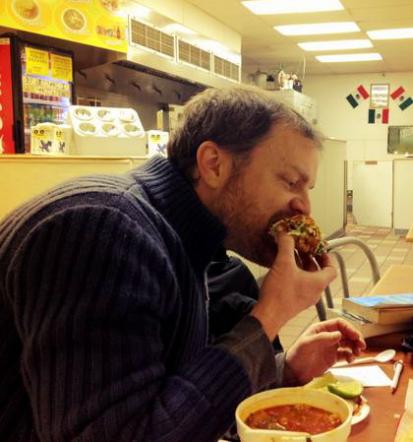
Lawrence Black is a writer and editor at Simple, Good and Tasty. He can be reached at lawrence@simplegoodandtasty.com. Look for him at your local Latin eatery. He is usually found looking overwhelmed and sweating.




